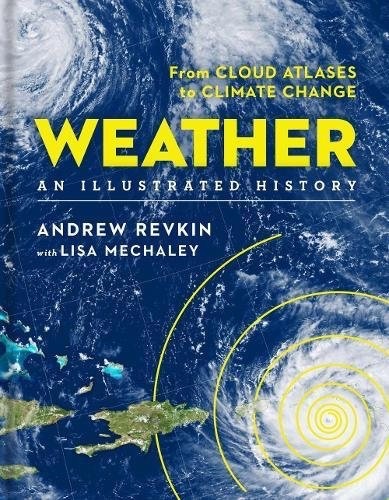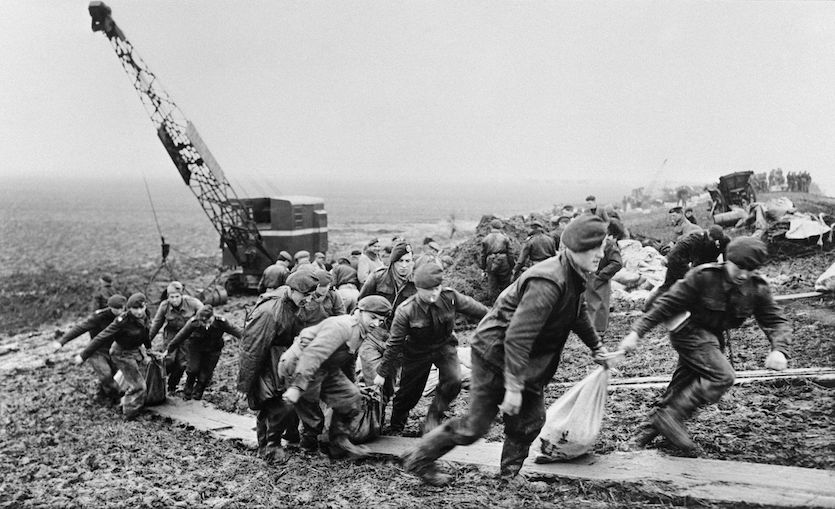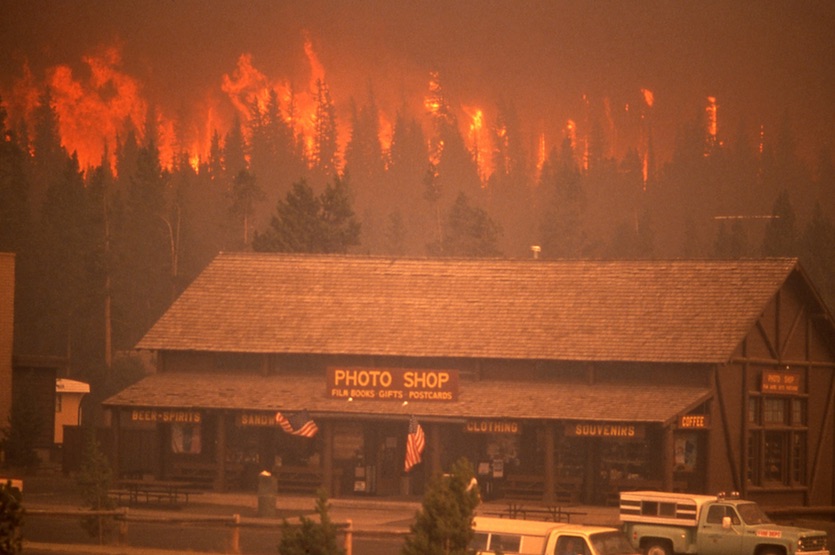| Above: A family in Brooklyn stands amid accumulations from the great Northeast blizzard of March 11-15, 1888, which led to more than 400 deaths. In a retrospective on the storm, WU weather historian Christopher Burt called it “the deadliest, snowiest, and most unusual winter storm in American annals. No storm of similar magnitude has ever occurred anywhere in the contiguous United States since.” Also referred to as “The Great White Hurricane,” the storm is one of 100 moments spotlighted in “Weather: An Illustrated History.” Image credit: Brooklyn Museum, via Wikimedia Commons. |
You’d be hard-pressed to find a more addictive romp through the story of Earth’s atmosphere than “Weather: An Illustrated History: From Cloud Atlases to Climate Change.” This new book is a fast and fun read, put together by Andrew Revkin (National Geographic Society), who served for many years as a science journalist at the New York Times, and Lisa Mechaley, an environmental educator and Revkin’s wife. Each of the moments is a highlight on its own, but there’s one from 30 years ago that resonates with particular force this weekend (more on this below).
 |
The book's format is ingeniously simple: a two-page spread for each event, with a full-page image on one side and a capsule description on the other. The book takes its historical mandate seriously, as its first “moment” is the formation of Earth’s atmosphere some 4.567 billion years ago. By the time we get to moment #11, we’ve zipped through various ages and epochs—including the “snowball earth” period a few hundred million years ago, and the “great dying” of the Permian Mass Extinction—and we've landed at the period around 100,000 years ago when modern humans began migrating out of Africa. These snapshots serve as an accessible micro-introduction to key events in paleoclimatology, including those areas where uncertainty still reigns.
The Renaissance kicks in at moment #21, with the invention by Galileo Galilei around 1603 of a proto-thermometer called a thermoscope, ushering in a period of rapid development of observing techniques for temperature, pressure, and humidity. By the 1750s, Ben Franklin gets a well-deserved double mention: one for his famed lightning research, and another for his less-well-known foray into storm chasing. While on horseback with his son William in rural Maryland in 1755, Franklin came upon a dust devil, which he estimated to be roughly 40-50 feet high by 20-30 feet wide. “The rest of my company stood looking after it,” Franklin wrote, “but my curiosity being stronger, I followed it, riding close by its side, and observed its licking up, in its progress, all the dust that was under its smaller part."
 |
| Figure 1. British mathematician Lewis Fry Richardson developed an interest in weather prediction during World War I. He came up with the idea of a “forecast factory”—a room where 64,000 people would carry out the type of laborious calculations that are now performed in seconds each day by numerical weather forecast models. Richardon’s first calculation-based forecast was a bust, as detailed in a 1922 paper (one of the 100 moments spotlighted by Revkin and Mechaley). However, the concept proved valid, and Richardson lived to see the first modern numerical weather forecast, which was carried out in 1950. Image credit: “Richardson’s Fantastic Forecast Factory,” Irish Times, via thatsmaths. |
For those of us into modern weather history, it’s great fun to see which landmarks of the 20th century Revkin and Mechaley chose to include. I was pleased to find that the Great Blue Norther of November 1911 made the cut. This jaw-dropping cold front raked the Great Plains with temperature drops that included a one-hour plummet from 82°F to 38°F in Columbia, Missouri. As an Oklahoma City native, I can’t resist noting that the city’s record high (83°F) and record low (17°F) for November 11 were both set that year (on 11/11/11)—and both records still stand.
Research and observing developments are woven into the mix, including the advent of hurricane-hunter flights in 1943 and the discovery of microbursts in the mid-1970s. As we move into the late 20th and early 21st centuries, human-produced climate change takes on an increasing presence, as one might expect. WU’s own weather historian, Chris Burt, gets a moment in the spotlight in the 2012 entry, “Settling a Hot Debate,” as part of the team that ended up disqualifying the global world heat record of 134°F in El Azizia, Libya, that had stood for almost a century.
 |
| Figure 2. Soldiers and civilians gather sandbags to strengthen dikes against the spring tide in the Netherlands during the North Sea flood of January 31–February 1, 1953. Triggered by a storm packing hurricane-force winds, the flood affected 350,000 acres and killed more than 1800 people. Image credit: AFP/Getty Images. |
With only 300-400 words per milestone, “Weather: An Illustrated History” is designed to serve more as a tasting menu than an exhaustive treatment of any one topic. Revkin and Mechaley make the most of the tight format, with the writing crisp and lively and the photos and illustrations nicely varied. The book’s structure works well for both a continuous reading and for dipping into the timeline as desired.
“Weather: An Illustrated History” (list price $24.95, available through Amazon or at your local bookstore) is a fun read for weather enthusiasts, and it’s also a handy primer for recruiting newbies into the wonders of our atmosphere. I give it five stars out of five.
The day that global warming became front-page news
One of the 100 moments spotlighted by Revkin and Mechaley—and deservedly so—is “Global Warming Becomes News,” about the rapid push of human-produced climate change into U.S. media during the summer of 1988. The weather context was an intense period of drought and heat enveloping much of the United States. By late spring, huge wildfires were raging in and near Yellowstone National Park, and barges were getting stranded in low water on parts of the Mississippi River.
 |
| Figure 3. Fire approaches the Old Faithful complex in Yellowstone National Park on September 7, 1988. Image credit: National Park Service, via Wikimedia Commons. |
NASA climate scientist James Hansen was scheduled to testify before the U.S. Senate on June 23—30 years ago this Saturday—on the impacts of human-produced greenhouse gases. Hansen had already appeared before Congress in November 1987, as noted by Spencer Weart in his definitive book “The Discovery of Global Warming” (available in full online from the American Institute of Physics). When Senator Tim Wirth proposed a return visit in 1988, Hansen suggested that summertime might be more effective than November for discussing global warming. As it turned out, Washington, D.C., hit a daily record high of 101°F on June 22, followed by another daily record of 98°F on June 23.
In his testimony that day, Hansen referred to his own calculations predicting that global temperatures in the 1990s would be clearly above 1950s levels, which turned out to be correct. He told Congress he had “99% confidence” that long-term warming was already under way, most likely due to the human-enhanced greenhouse effect. He later told reporters it was time to “stop waffling.” Against the ongoing U.S. backdrop of heat, drought, and fire, Hansen’s testimony was front-page news, and the concept of global warming quickly entered public consciousness.
An excellent five-minute video produced by Peter Sinclair—published this week by Yale Climate Connections, and embedded above—delves into the legacy of Hansen’s testimony and his bold predictions of the late 1980s. “Based on what we knew in 1988, Jim Hansen was out on a limb. You could have reached an alternative conclusion fairly,” said Andrew Dessler (Texas A&M University). The first assessment report from the IPCC, released in 1990, concluded that recent global warming up to that point had been of roughly the same magnitude as natural variability. Hansen was “out on one end of how you could read the data,” said Dessler, “but it turns out he was right.” Over the past 30 years, global temperature rise has been close to the middle of three projections offered by Hansen at the time.
After the cataclysmic eruption of the Philippines’ Mt. Pinatubo in 1991, Hansen correctly predicted that global temperatures would dip and then recover within several years. “You’ve got to get a lot of physics right in order to get that recovery timescale right,” noted Ben Santer (Lawrence Livermore National Laboratory).
Seth Borenstein (Associated Press) recently interviewed Jim Hansen to get his take on that historic 1988 testimony and what’s happened since. On Twitter, see the hashtag #30YearsofWarming for more from Borenstein and other writers.
In June 1988,James Hansen testified global warming here; '88 was hottest year on record then; now ranks 25th. World warmed by nearly 1dF in 30 years; #30YearsofWarming pic.twitter.com/Hn1ZDcfhAE
— seth borenstein (@borenbears) June 16, 2018




